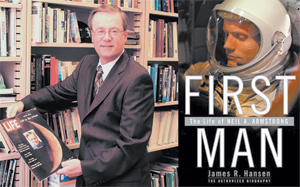THE MISSING ‘A’

Last year, October 27, 2005, Jim Hansen was at Barnes & Noble at Jefferson Point, kicking off a national book-signing tour for his new book, First Man, the only authorized biography on Neil Armstrong.
Jim, a former Waynedale resident, was asked about the phrase Armstrong made after his first step on the moon. Jim said, “What Armstrong meant to say was… “One small step for a man, one giant leap for mankind.” He inadvertently left out the ‘a’ leaving a quote that was not exactly what he had planned.
What’s a little ‘a’ among friends, you may ask. Well, for one thing, leaving out that ‘a’ created a statement that was grammatically incorrect. Armstrong, 76, has often said that he didn’t leave out the ‘a’ when he made the famous quote.
The discrepancy has been widely debated for years by historians, academics and fans of space travel, with the ‘a’ sometimes appearing in parentheses in government documents and Armstrong being listed on unofficial websites as being guilty of a momentous flub.
Critics have suggested that Armstrong either botched it or that the poor wording was a sign of his lack of awareness of its significance. The website, www.slipups.com, notes, “Mr. Armstrong’s quote left out that ever important letter ‘a.’ His quote without the ‘a,’ basically said ‘One small step for mankind; one giant leap for mankind.’ ”
Armstrong told Hansen that others have pointed out that he can often be heard dropping the vowels from his speech in his radio transmissions.” It didn’t sound like there was time for the word to be there,” Armstrong said in the book. “On the other hand, I didn’t intentionally make an inane statement, and … certainly the ‘a’ was intended, because that’s the only way the statement made any sense.
“So I would hope that history would grant me leeway for dropping the syllable and understand that it was certainly intended, even if it wasn’t said … although it might actually have been.”
Neil was 39 years old when he landed on the moon, and even though he has listened to the tapes and others have listened to the tapes you would think he would just say, “OK, I made a mistake,” but you can tell by his answers to reporters queries that he has always thought he said it correctly. After all, Neil stayed alive during his years as a test pilot by paying attention to details and doing things preciously correct.
The missing word was found this month, in a software analysis of Armstrong’s famous phrase by Peter Shann Ford, a Sydney, Australia-based computer programmer. Ford’s company, Control Bionics, specializes in helping physically handicapped people use their nerve impulses to communicate through computers.
Ford and Hansen presented the findings to Armstrong and others in a meeting at the Smithsonian Institution’s Air and Space Museum in Washington, D.C. They repeated the presentation at NASA’s Washington headquarters, which has long backed Armstrong’s version of the phrasing.
According to Ford, Armstrong spoke, “One small step for a man…” in a total of 35 milliseconds, 10 times too fast for the ‘a’ to be audible. The ‘a’ was transmitted, though, and can be verified in an analysis using Canadian sound-editing software called GoldWave.
Ford began his detective work in September after a bicycle ride in Ohio. As he rested, he reflected on a favorite topic from his days as a medical student: the Apollo 11 moon landing.
“When they started talking about the phrase … I thought that was pretty stupid,” Ford recalled. “They just put a man on the moon, why worry about an ‘a’? Later, I thought Armstrong was such a good pilot, so precise, it’s unlikely he would actually screw up a line.”
Ford’s interest was fueled as well by his work as a Cable News Network anchorman more than two decades ago, when his duties included news coverage of NASA.
He used his computer to download the audio recording of Armstrong’s words and analyzed the speech pattern with the computer software.
In the graphic tracing, he found a signature for the missing ‘a,’ evidence it was spoken and transmitted. Ford then checked First Man and found Hansen’s account of Armstrong’s historic step, as well as the astronaut’s explanation. The account matched what he had found with the computer analysis.
Ford contacted Hansen and compiled his findings in a scientific paper.
“It was meant for all mankind, and it’s important to have it correct,” Hansen said. “It’s a concise, eloquent statement for the ages at a unique milestone for our species.”
In the overall scheme of world history, it’s probably not that significant. But it’s nice to know that what Armstrong thought he said, he actually did say.
- What To Know About Mosquito Season - July 19, 2024
- Local Worship & Events: July 19 Update - July 19, 2024
- Allen County Bar Foundation Announces Scholarship Winners - July 19, 2024


